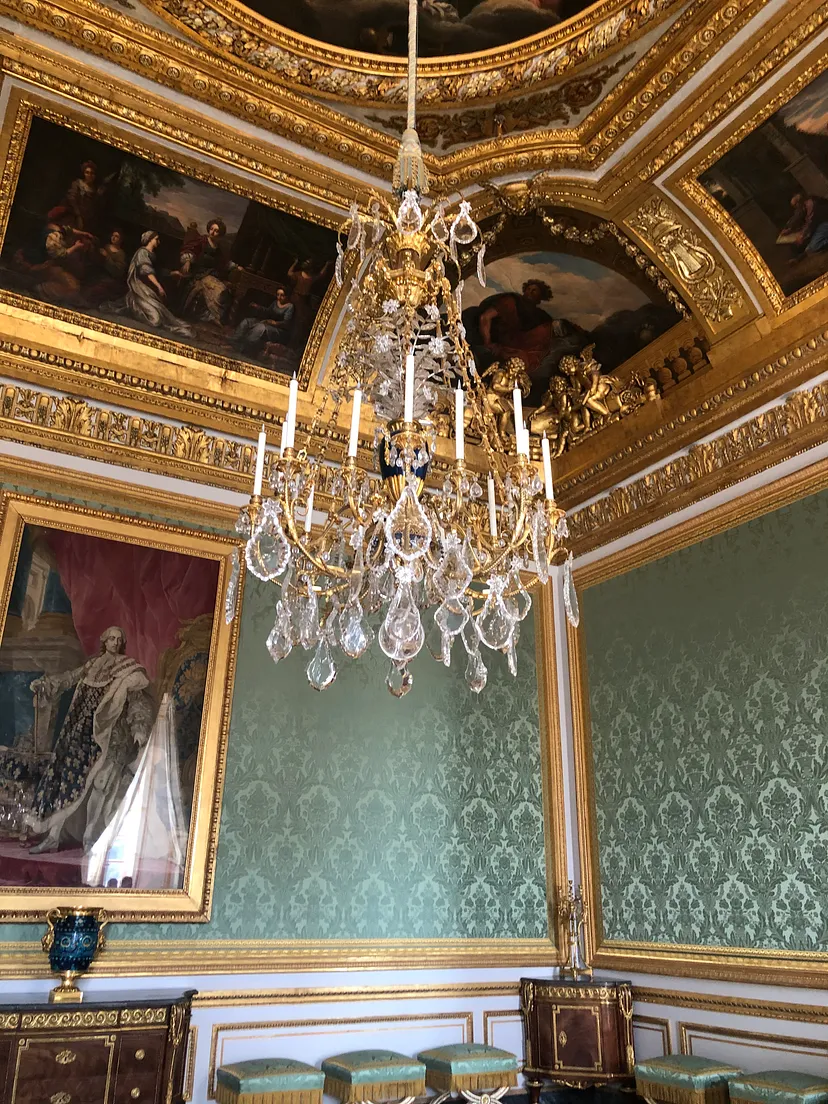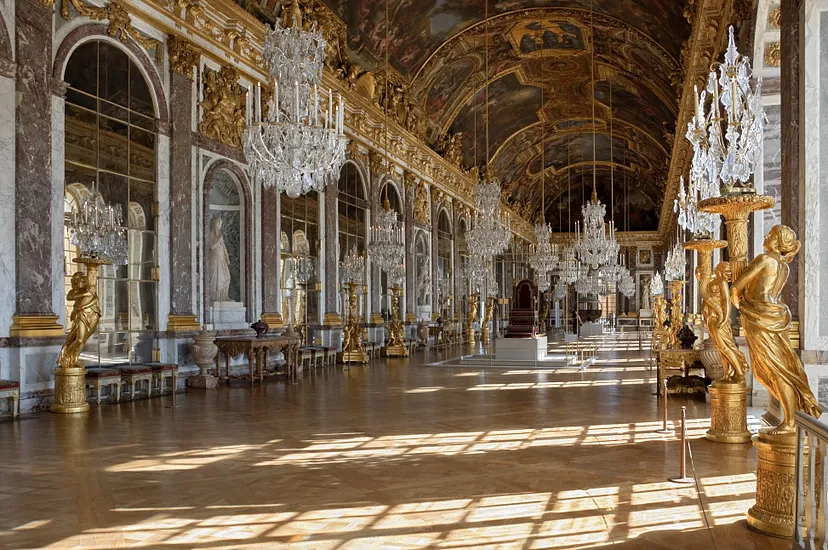

My visit to Palace of Versailles in France made me witness the History of Taste of King Louis XIV .Sharing and Describing the baroque style here.
The Baroque period in art history came after the Renaissance and was characterized by the use of abundant ornamentation. Baroque style started in 1600 in Rome , Italy, and spread throughout the majority of Europe during the 17th and 18th centuries. when it was gradually replaced by the Rococo style. This type of art was meant to be understood by the uneducated masses, as opposed to the cultivated audience targeted during the Renaissance.

The Catholic monarchies adopted this style as a way to exhibit their wealth and power, and Baroque art expanded throughout the Catholic regions in Europe and the Americas. Designers began to produce elaborate and ornamented pieces for the monarchy, and this fashion was gradually adopted by other courts all over Europe. Baroque Furniture's were epitomized by Louis the XIV Th and Versailles. It is opulent and a heavier style — more “serious.” Rococo is often considered a subset of the Baroque era, sometimes even called late Baroque. It is typically lighter, more feminine and whimsical. Giving a bedroom a touch of Baroque or Rococo is easy to do. Some of the pieces produced for the French king Louis XIV became symbols of Baroque furniture and are also known as the Louis XIV style, which is highly demanded by many antiques enthusiasts and collectors.
The Palace of Versailles is the world's most opulent playground for royalty! A chateau large enough to house 6,000 courtiers! A palace fit for a king!
And not just any king, but Louis XIV, the "Sun King," who reigned for 72 years and whose self-glorification knew no bounds. Starting in 1661, he transformed a humble hunting lodge into a glittering palace. He drained swamps and moved whole forests to create 250 acres of formal gardens, tree-lined paths, flowerbeds, lakes, and fountains. And this filled only a small portion of the grounds -- the entire estate covered 2,000 acres.

Baroque and Rococo decor are popular styles, and bedrooms are one of the places in your home where these eras of design can shine. The characteristics of Baroque furniture and Rococo elements are perfect for a space meant to be opulent, relaxing and luxurious. Curving lines, ample embellishment and sumptuous fabrics, which are typical of these styles, make a bedroom extra special.

The first element of these styles to consider is gold. Because wood was always a prominent feature in Baroque furniture, gilding was often applied and the ornamentation was almost always done in gold. These bedroom features several telling characteristics, such as the extravagant gold ornamentation atop the tufted headboard. While that is decidedly Baroque, the lavish bedding is more Rococo because it is made from silk. Despite the elaborate ornamentation, Baroque compositions had a delicate balance and a harmonious integration of all elements. The furniture pieces were usually symmetrical, and all the details were replicated on both sides, with very small variations, if any.

Dr. Vinita Mathur at Palace of Versailles , France
The general layout often included twisted columns, which incorporated plenty of curves for giving a sense of dynamism. In most tables, cabinets, armoires and tall furniture, pedestal feet were common, usually diagonally interlaced. The four legs were usually the only elements to touch the floor. Heavy moldings were used to decorate not only the uppermost part but also the top of each section where there was an important change in size, like on top of the pedestals and lower drawers. For decorating the crown moldings, a wide variety of elements were used, from pediments to sculptures.

The palace of Versailles.

Palace of Versailles
The establishment of regular trade routes between Europe and Asia influenced the materials used. Imported tropical woods were highly demanded and were considered exotic and exclusive. Ebony and mahogany were used in many pieces, while some of local woods included oak, walnut and chestnut.
Elaborate compositions made with inlays became characteristic of Baroque furniture. The inlays were made by inserting veneer (thin pieces of wood) of contrasting colors or from different materials, like metals and ivory. Marble table tops were also common, and craftsmen used different types for creating contrasting compositions.

By the turn of the 18th century, the gilded finish was the trend. It was made by covering the surfaces of a furniture piece in gold leaf. Gold was associated with wealth, and having golden furniture was the ultimate luxury. Golden chandeliers and frames for mirrors or paintings also became popular among the European courts. Even doorknobs had an elaborate design and golden decoration.
An ornate headboard is enhanced with lavish draping, flanked by wall panels that with generous embellishments of several kinds. Gilded and ornamented nightstands with shorter legs and a more bombe shape, which is of the Baroque era.There are feminine painted floral pattern on the furniture hints at Rococo.You will find ample gilding, paneled walls and generous draping make for a Baroque bedroom with a weighty feeling.

The carved embellishments of this era are amazingly intricate. Baroque style used a great deal of plant life in its ornamentation, including scrolling foliage and garlands of flowers. The masses of scroll work on the bed, nightstand and dresser carefully accented with gold can be seen in baroque style.
The motifs for decoration were usually stylized foliage and geometric, with spirals and curves. Figurative details like cherubs, chubby children and animals were usually used as ornamentation on the corners and the top of the legs. Carving or inlaying the crests and initials of the owner also became a symbol of status.

Regal is the best way to describe the Baroque bedroom, done up in rich colours and ornately carved furniture.

Palace of Versailles ,Paris
Another popular decorative element during the Baroque period was a heraldic crest or a monogram. The kingly bed below and a centerpiece emblem that represents where a crest would likely go. In fact, the term Rococo originates with the French word rocaille, which denoted the shell-covered rock work that was used to decorate artificial grottoes, according to Britannica. Rococo style has very feminine frills and frou-frou that decorate the room. The gilded carvings on the bed are floral, the legs of the nightstands are embellished and bedding and lamps are dressed with flowers and ruffles. A dimly lit room belongs to Baroque style . In all I feel its the most beautiful style full of opulence and Grandeur I have ever come across.
The author of this article is Dr. Vinita Mathur (vinita @dezyneecole.com),she is an esteemed educationist, and the visionary owner of a prestigious college ,Dezyne École College . Her intellectual prowess, dedication to education, and innovative leadership have made her a prominent figure in academia and a source of inspiration for countless students and educators alike.
Through her scholarly pursuits, educational leadership, and commitment to empowering students, she has left an indelible mark on the educational landscape.